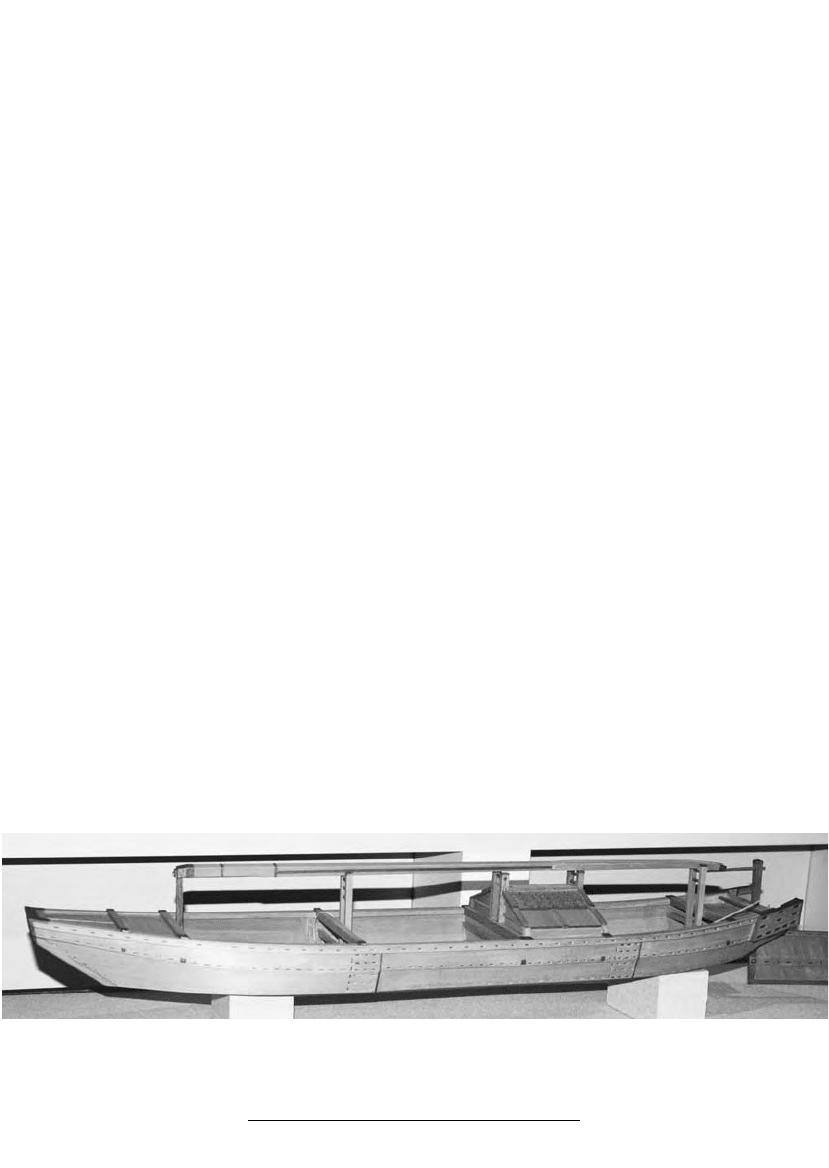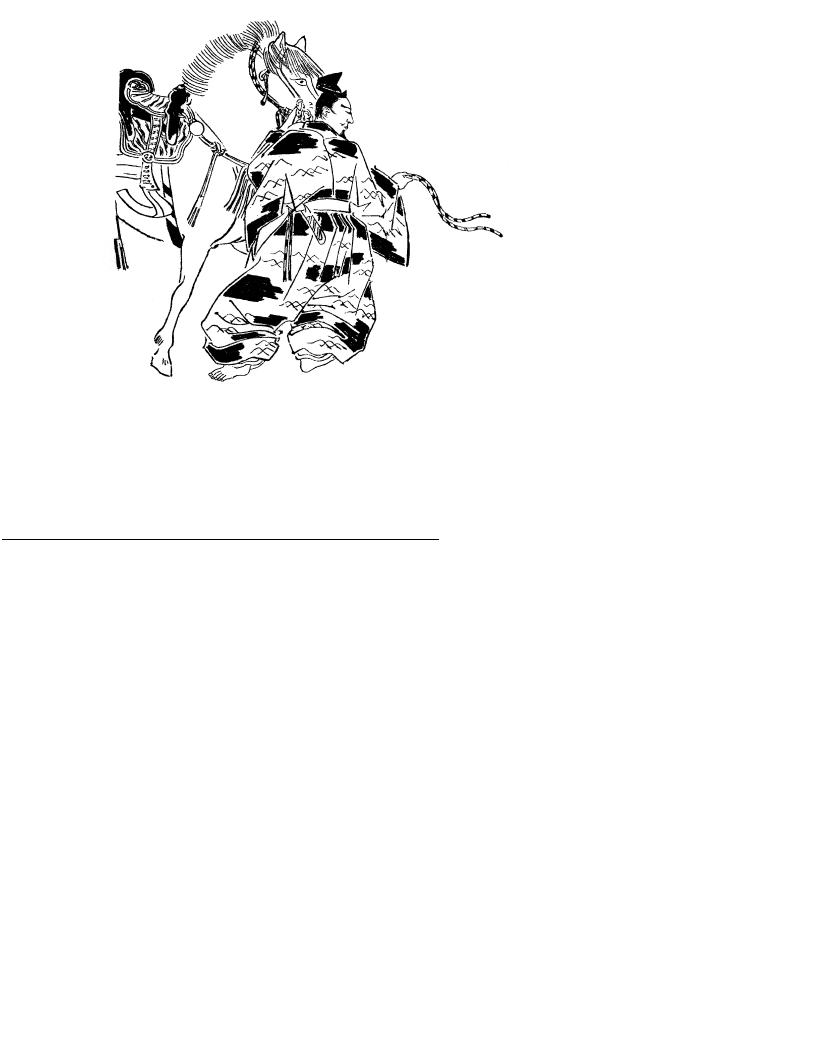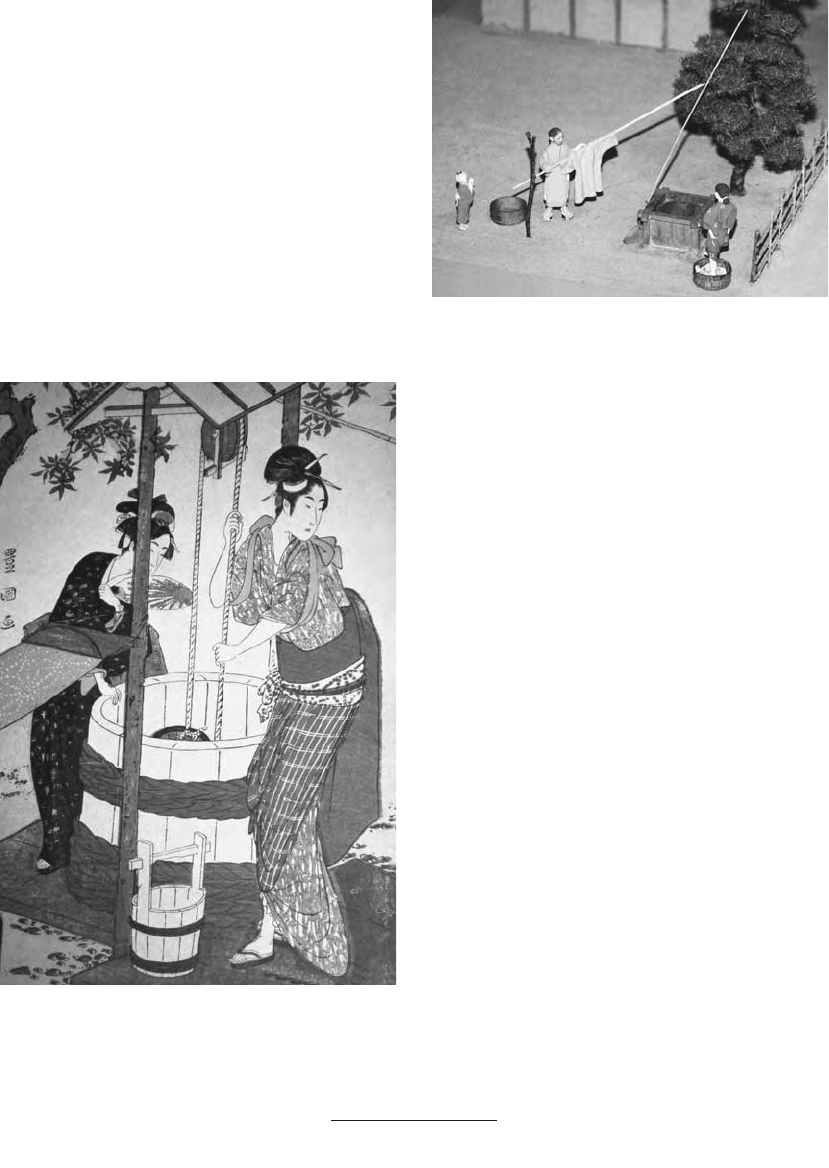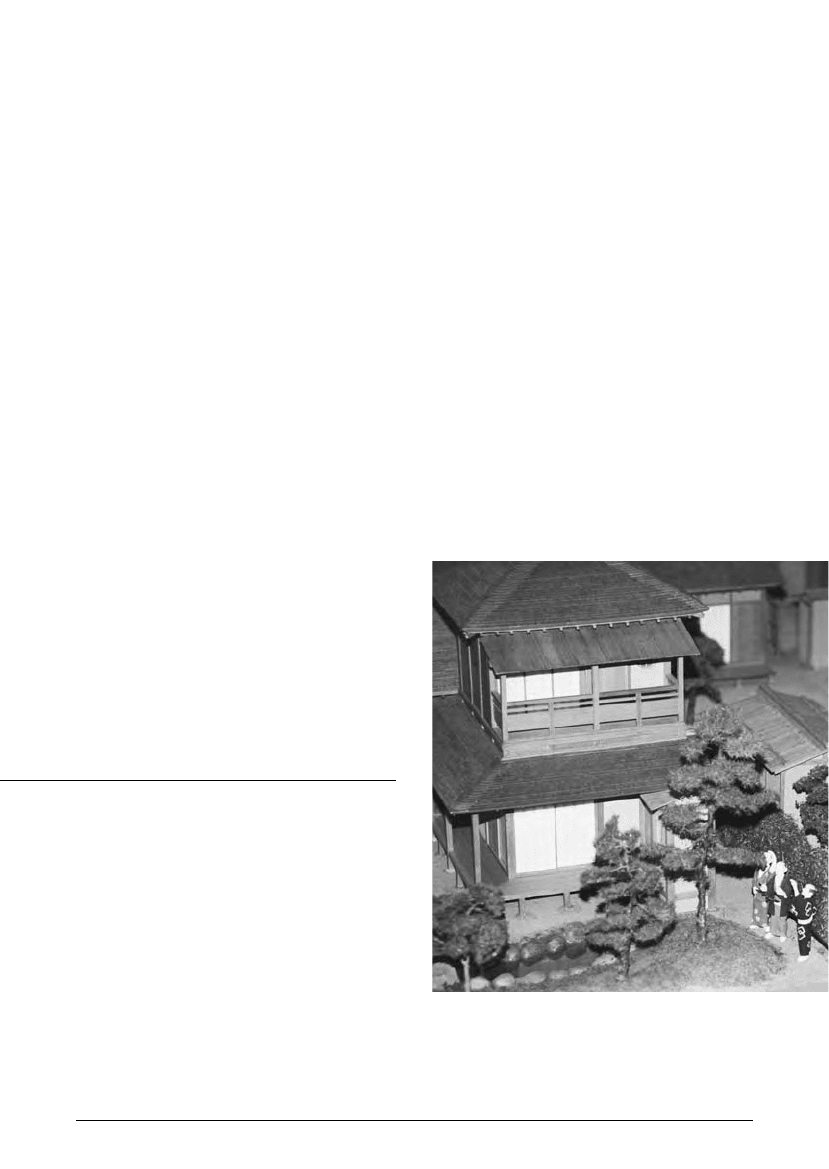Deal W.E. Handbook To Life In Medieval And Early Modern Japan
Подождите немного. Документ загружается.


maritime activity. Japanese ships sailed to Korea,
China, and as far away as Southeast Asia for trade and
also to transport embassies on their foreign missions.
In the Kamakura period, for instance, ships traded
with Southern Song–dynasty (1185–1333) China,
although this was not an extensive trade arrange-
ment. Both trade and the exchange of envoys
expanded in the Muromachi period. Ashikaga
shoguns promoted the so-called tally trade (see chap-
ter 4 for details) with Ming-dynasty (1368–1644)
China. These activities required the ability to build
boats both large and strong enough to make the haz-
ardous ocean crossing. In the medieval period, sail-
ing ships were constructed expressly for trade and for
dispatching envoys to China and Korea.
Ocean travel was possible, in part, because of
advances in technology. Among significant advance-
ments in the medieval period was the use of naviga-
tional charts that included latitude and longitude
markings. Charts became available for areas includ-
ing China, Korea, and Southeast Asia. By the end of
the medieval period, the magnetic compass and such
astronomical instruments as the quadrant and the
astrolabe were being utilized for more accurate nav-
igation, especially on long voyages.
Another aspect of medieval maritime travel and
communication that impacted both the movement
of ships generally and trading vessels in particular
was the activity of Japanese pirates (wako). Although
wako were referred to as Japanese pirates, in fact,
Koreans, Chinese, and others sometimes partici-
pated in these illegal bands. Active mostly in the
medieval period, pirates attacked and pillaged
the coasts of both Korea and China. In the 13th cen-
tury, pirates raided the coast of Korea, and such
attacks continued intermittently for two centuries.
Although the Korean government appealed to the
shogunate to control the pirates, they were mostly
ineffective in dealing with the problem. In the late
14th century, Korea successfully fought back against
the pirates, though pirate activities continued in
diminished form through the 16th century.
By the middle of the 14th century, Japanese
pirates were venturing further from Japan. They
attacked the Chinese coast in 1358, and for the next
200 years they continued to harass Chinese commu-
nities up and down the mainland coast. In an effort
to combat these raids, the Chinese set up coastal
defenses and limited coastal trade. One result of the
Japanese pirate activity was that the Chinese govern-
ment placed increasing pressure on Japan to control
or destroy the pirates. Trade agreements between
China and Japan began to hinge on the ability of the
shogunate to suppress pirate activity. The medieval
tally trade, for instance, was predicated on Japanese
control of pirate bands. During the Warring States
period, pirate activity increased because there was
no central power available to keep them in check. It
was only after Toyotomi Hideyoshi took control of
Kyushu—one of the staging grounds for pirates—in
his late 16th-century quest to unify Japan that pirate
activity diminished.
Early Modern Maritime
Travel and Communication
Medieval period accomplishments in foreign trade
and travel were abandoned in the early modern
period. International trade and long-distance travel
were forbidden by the Tokugawa shogunate once
the national seclusion policy was decreed in the first
half of the 17th century. In order to assure adher-
ence to this ban on international travel, the shogu-
nate further restricted the size of ships that could
legally be constructed. Thus, the order was issued
forbidding the building of ships with capacities of
more than 500 koku (49 gross tons).
In the Edo period, the development of a regu-
lated road system was vital to the expansion of travel
and communication, which were closely connected
to the development of the early modern economy.
Also vital to this process was the development and
improvement in maritime travel and transport capa-
bilities. To this end, maritime infrastructure—
including docks, warehouses, and canals—was built
or improved, and new coastal shipping routes were
established to better link the provinces with major
cities like Osaka and Edo.
Because of the ban on the construction of large
ships, domestic maritime travel was mostly restricted
to the use of small wooden sailing ships appropriate
for use on Japan’s coastal and inland waterways. Dur-
ing this time, such ships played a vital role in the
H ANDBOOK TO L IFE IN M EDIEVAL AND E ARLY M ODERN J APAN
334

expansion of the economy and the growth of urban
centers, such as Edo. Over time, the shogunate con-
tinued to forbid foreign trade and travel, but it did
relent on the maximum size of trading ships because
of their importance to the burgeoning domestic
economy that relied on coastal shipping to transport
rice and other staple goods from area to area. The
route between Osaka and Edo was particularly
important, as were routes from other areas of Japan
into these two large urban areas.
As the populations of urban centers grew over the
course of the early modern period, and consequently
the demand for essential commodities, the need for
more efficient transportation and distribution net-
works to deliver these goods to market also increased.
Osaka developed as a central collection and distribu-
tion center for goods produced in various parts of
Japan. It was necessary to create an efficient method
to transfer goods to Osaka, and then from there to
Edo. The transportation routes then in use combined
sea transport to a particular collection point where
goods were offloaded from ships and taken by land to
Edo, Osaka, or some other destination. The solution
was to use ocean routes that linked provincial ports
directly with Osaka, and Osaka with Edo.
The Tokugawa shogunate embarked on such a
project in the latter half of the 17th century when it
engaged the wealthy merchant Kawamura Zuiken
(1617–99) to establish new coastal shipping routes.
Kawamura set up a complete circuit around Japan
using two primary routes, the eastern sea circuit
(higashi mawari) and the western sea circuit (nishi
mawari). Prior to Kawamura’s endeavor, ships had
avoided certain ocean areas because of the fear of
shipwrecks in particularly treacherous waters. Kawa-
mura charted the coastal waters and established light-
houses to guide ships through dangerous stretches of
ocean. The eastern sea circuit ran from the Sea of
Japan to western Honshu and then through the
Inland Sea (Seto-naikai) to Osaka and Edo. The west-
ern sea circuit took ships from the Sea of Japan north
through the Tsugaru Strait and then down the Pacific
Ocean border of Japan into Edo Bay.
Japan’s isolation from most of the rest of the
world lasted more than 200 years, until it was inter-
rupted when Admiral Perry arrived in 1853 and
demanded that Japan open its ports to foreign trade.
Aside from the political fallout from this event, it
became evident to Japanese shipbuilders that Japan
had fallen behind technologically in its ship designs.
The subsequent Meiji period witnessed not only the
revival of foreign trade, but the design and construc-
tion of new ships using Western technologies. Alter-
nate modes of propulsion, such as steam engines,
were introduced at this time.
Examples of Boat and
Ship Types
Boats and ships were an important mode of domestic
and international travel in the medieval and early
modern periods. Because of their diverse uses, ships
came in many different sizes and shapes but were
always made of wood or other natural materials, until
the end of the early modern period when Western
shipbuilding techniques were formally introduced to
Japan. Ships used for trade were built in ways differ-
ent from ships used in warfare. A fishing boat was
appointed differently than a boat used to take
leisurely cruises down a river. The boats that carried
lords to their duties in Edo were different from the
boats that carried sake to market. The following list
details some of the different kinds of ships and boats
in use during the medieval and early modern periods.
ATAKE-BUNE
The atake-bune was a type of naval warship that was
used in battles during the Warring States period and
into the early Edo period. These vessels were any-
where from about 20 to 65 feet in length. Atake-bune
included a wooden tower from which arrows or
matchlock guns could be fired at the enemy. Twenty to
25 oarsmen were needed to propel these large ships.
BEZAISEN
Bezaisen, also known as sengoku-bune (1,000-koku
ships), were large ships widely used from the end of
the medieval period to transport goods to market.
These ships had a flat keel and were propelled by a
single square sail on one mast. The earliest bezaisen
had a relatively small capacity, but as the need to
carry more commodities per voyage increased, so
T RAVEL AND C OMMUNICATION
335

did the capacity of the newer versions of this ship
design. By the beginning of the 18th century, the
usual capacity of a bezaisen was 1,000 koku (98 gross
tons), thus earning the vessel the name sengoku-bune.
These larger bezaisen carried a crew of 15 or so.
They operated originally in the Inland Sea, but
later traveled a much longer distance, including voy-
ages in the southern part of the Sea of Japan and up to
Edo. These ships also sometimes took another route
to Edo, sailing through the strait between Honshu and
Hokkaido, and then traveling south to Edo. From the
beginning of the early modern period, bezaisen played
an active role in the growth of domestic maritime
trade. Bezaisen were related to such other transport
ships as higaki kaisen and taru kaisen (see below under
kaisen) as well as kitamae-bune (see below).
CHOKI-BUNE
The choki-bune was a riverboat used especially in cities
as a water taxi to ferry passengers from shore to shore.
GOZA-BUNE
Generally, goza-bune were large boats used by aristo-
crats or high-ranking warriors. They were also
brightly decorated for use in a festival and on other
occasions. Goza-bune were built both for use in the
ocean and on rivers. Oceangoing goza-bune (umi-
goza-bune) were essentially warships used to demon-
strate a warrior’s power during peaceful times of the
Edo period. One famous example of an oceangoing
goza-bune was the ship known as Tenchi Maru, a ver-
milion-lacquered vessel built by the third Tokugawa
shogun, Iemitsu, in the 1630s.
In contrast, rivergoing goza-bune (kawa-goza-
bune) were elegant vessels designed for use by high-
ranking warriors for travel by river. Rivergoing
goza-bune used oars and poles instead of sails.
HIGAKI KAISEN
Higaki kaisen were cargo ships that transported
essential commodities—such as oil, vinegar, soy
sauce, wood, and cotton—from Osaka to Edo. A
kind of circuit ship (see kaisen), higaki kaisen were
related to the cargo ship known as a bezaisen (see
above). Higaki kaisen were used especially by the
Sakai merchants.
HIRATA-BUNE
The hirata-bune was a large riverboat from 50 to 80
feet long, similar to a takase-bune (see below). This
long and narrow boat with a flat bottom was used to
transport freight. The largest of the hirata-bune had
a capacity of 300 koku (53 gross tons).
KAISEN
The term kaisen, or “circuit ship,” is a generic term
for cargo ships used to ship goods on consignment or
to deliver goods to market. Such boats were first used
with some regularity in the middle of the 13th cen-
tury in the Inland Sea. By the late Kamakura period,
however, circuit ships were transporting goods back
and forth from distant ports both north and south.
The government issued maritime rules known as
kaisen shikimoku (literally, “circuit ship regulations”)
to regulate the use of circuit ships in trade.
From contemporary records, it is apparent that
circuit ships were important to economic growth in
the medieval period. Various kinds of circuit ships
were also central to the development of trade in the
early modern period, and are notably associated with
the transport of goods between Osaka and Edo. Cir-
cuit ships made good use of the new sea-circuit trade
routes established in the last half of the 17th century.
It was not until the late 19th-century importation of
Western technology, such as the steamship, that the
use of circuit ships diminished. See also higaki kaisen
and taru kaisen.
KEMMINSEN
In the last half of the 14th century, Ashikaga shoguns
inaugurated the so-called tally trade with Ming-
dynasty China (1368–1644). From 1404 to 1547, 17
missions involving 84 ships made the journey to
China. The ships that made this crossing were known
as kemminsen (ships dispatched to the Ming dynasty).
They combined two purposes: foreign trade and for-
eign relations. Thus, these ships carried both goods
to trade and official envoys, known as kemminshi
(envoys to the Ming dynasty). Merchants also accom-
panied these voyages. In total, a single ship might
carry as many as 200 people, including the crew.
Kemminsen were newly built to meet the needs of
these voyages. They were large: records report that
H ANDBOOK TO L IFE IN M EDIEVAL AND E ARLY M ODERN J APAN
336

they had a capacity between 1,000 and 2,500 koku
(between 98 and 245 gross tons). These ships sailed
using two masts with matted square sails. There was a
cabin on deck that was specially appointed to accom-
modate the needs and tastes of the envoys on board.
KITAMAE-BUNE
Kitamae-bune, also known as hokkoku-bune, were a
regional variation of a bezaisen (see above). These
were very large ships—some with a capacity as great
as 1,000 koku (98 gross tons)—used to transport
cargo during the Edo period. The term kitamae
means “northern area,” and kitamae-bune operated
from northern areas of the Sea of Japan transporting
commodities to markets in central Japan. Kitamae-
bune were designed so they could carry the greatest
capacity for their size. Although a square sail was the
primary means of propulsion, these ships could also
be rowed. Northern Japan was only sparsely popu-
lated, and few of its customs were known in the cen-
tral parts of Japan. One of the consequences of the
kitamae-bune trade was that northern styles of cloth-
ing, song traditions, and differences in dialect
became known to a wider Japanese audience.
SEKI-BUNE
Seki-bune was a type of Japanese warship used in the
Warring States period and at the beginning of the
early modern period. Unlike its contemporary, the
atake-bune, the seki-bune was much smaller and faster.
SHUINSEN
At the end of the Azuchi-Momoyama period and the
beginning of the early modern period, the govern-
ment tried to control overseas commerce and travel
by issuing trading permits known as “vermilion seal
licenses” (shuinjo) to those who desired to engage in
foreign trade. Merchants from Kyoto, Sakai, and
Nagasaki were particularly involved in international
trade under this arrangement.
The ships used by merchants with permits were
known as “vermilion seal ships” (shuinsen). Vermil-
ion seal ships were oceangoing sailing ships that
were built within Japan and also imported from
China and Siam (Thailand). These were large ships
that could be as much as 130 feet in length with a
capacity of up to 4,225 koku (750 gross tons). Their
design features were a hybrid of Chinese, Por-
tuguese, and Spanish ships. Shuinsen had three masts
and double keels. They reportedly used a crew of 80
and could accommodate as many as 320 passengers.
Before foreign trade was forbidden by the shogunate
in the 1630s, some 350 shuinsen voyages were made
to locations as far away as Southeast Asia.
TAKASE-BUNE
Like the hirata-bune, the takase-bune was a type of
long and narrow riverboat with a flat bottom. It was
used to transport freight (typically on the Takase
River) and also for work in rice paddies.
TARU KAISEN
Taru kaisen were cargo ships that were used specifi-
cally to transport sake in barrels (taru), though these
boats sometimes carried other products, from Osaka
to Edo. A kind of circuit ship (see kaisen), taru kaisen,
like the higaki kaisen, were related to the cargo ship
known as a bezaisen (see above). Taru kaisen were
propelled by a single sail and had reinforced hulls in
order to hold the heavy barrels they transported.
T RAVEL AND C OMMUNICATION
337
11.5 Model of a takase-style boat used during the Edo period (Edo-Tokyo Museum exhibit; Photo William E. Deal)

YAKATA-BUNE
Yakata-bune was a type of luxury riverboat used for
leisure activities by the wealthy.
YU-BUNE
An unusual boat, a yu-bune was a floating public bath.
At the center of the boat was an enclosed central
space for the bathtub. Water for the bath was heated
using firewood. Customers, who were typically crews
from cargo ships and dock workers, paid a fee to use
the bathing facilities on board the yu-bune.
EUROPEAN SHIPS IN JAPAN
Japanese exposure to the West in the transition
period from the medieval to the early modern
period, and again in the middle of the 19th century,
introduced the Japanese to new shipbuilding styles
and methods. In the early 17th century, for instance,
the Japanese built two English-style ships with the
guidance of Will Adams, an English sailor living in
Japan. With the help of the Spanish, a larger West-
ern-style ship was built a decade or so later. This
particular engagement with Western shipbuilding
was cut short, however, by the national seclusion
policy enacted by the Tokugawa government in the
1630s.
Interest in Western ships and shipbuilding was
revived when, in 1853, Admiral Perry sailed into
Uraga Bay in his “black ships” (kurofune), named for
their color. Of the four ships that Perry com-
manded, two used sails and two were steamships.
The Japanese were at once intrigued by the possibil-
ities of a steam-powered ship, but they were also
aware of the necessity of updating their own war-
ships to match the power of their Western rivals.
The government received a steam warship from
Holland and purchased another one. It was not until
the Meiji period, however, that Japan developed the
technology to build its own modern warships.
READING
Travel and Communication
Frédéric 1972, 88–89: travel in the medieval period;
Nishiyama 1997, 104–109: transportation and travel
in the early modern period, 132–135: Ise pilgrimage,
135–137: Kompira pilgrimage, 131–132: Kumano
pilgrimage, 139: Shikoku pilgrimage, 139–140:
Shinran pilgrimage, 137–139: 33 sites pilgrimage;
Dunn 1972, 23–28: samurai travel and roads in the
early modern period; Cullen 2003, 53: roads, 82–83:
commercial transportation, 89: Nakasendo, 88–90:
road traffic, 70, 89: Tokaido; Totman 1993, 153–157:
roads, travel, maritime transportation, and commu-
nication in the early modern period, 443–445: early
modern pilgrimage, 325–327: road construction and
maintenance in the early modern period, 71–72:
promotion of commercial travel in the early modern
period; Cortazzi 1990, 145–146: road and maritime
transportation in the early modern period; Totman
2000, 233–235: early modern roads and transporta-
tion; Totman 1974, 101–102, 116: early modern
communications; Jansen 2000, 134–141: early mod-
ern communication and travel; Yamamura (ed.)
1990, 364–366, 381–383: transportation in the
medieval period; Hall (ed.) 1991, 114–115, 117,
530–531, 551–553, 567–568: early modern trans-
portation; Jansen (ed.) 1989, 64–65: travel in the
19th century; Traganou 2004: travel and communi-
cation along the Tokaido in the Edo period
H ANDBOOK TO L IFE IN M EDIEVAL AND E ARLY M ODERN J APAN
338

EVERYDAY LIFE
12

THE FAMILY
Family Structure
Medieval and early modern Japanese society was hier-
archical. By the end of the 17th century, this hierar-
chy was divided, at least in the ideal, into four distinct
classes: samurai, peasant, artisan, and merchant. In
turn, this overarching hierarchical framework shaped
the composition of the family unit. Interclass mar-
riage was not legally permitted, thus forcing individu-
als to marry along socioeconomic lines. This
structure perpetuated the dominant hierarchical para-
digm, preventing individuals from attempting to
change their social and occupational status.
In both medieval and early modern Japan, the
basic family unit was the ie (house). While the ie tradi-
tionally consisted of a nuclear family, it typically
expanded to incorporate an assortment of other
members, including blood relatives, such as grand-
parents, and nonrelatives, such as servants and their
kin. In addition to being the foundational component
of social organization, the term ie also referred to
notions of family property, reputation, and the princi-
ple of continued familial succession. Typically, the
eldest son became the inheritor of the family. How-
ever, when there were no legitimate blood kin to
assume control, external heirs unrelated to the family
were often adopted into the household as successors
to carry on the family lineage. This ethos of genera-
tional continuity and heritage reflects the Confucian
influence on early modern Japanese culture. Particu-
larly during the Edo period, the upper classes adopted
the familial tenets of Confucianism, leading to the
priority of filial obligation, obedience, and loyalty.
Overall, individuals were expected to sacrifice their
own well-being or personal desires for the greater
good of the family structure. Ie as a unit or principle
can be seen throughout Japanese culture well before
the medieval era. However, ie was particularly promi-
nent during the Edo period when strong economic
developments allowed even commoners to establish
their own line of succession for the first time.
The traditional size of the ie was around five peo-
ple. If a person within the family was lost, extra
responsibility was either assumed by the other family
members (within poor classes) or delegated to ser-
vant workers (within wealthier families). The head of
the household (koshu) was traditionally male and held
the greatest responsibilities for running the ie. How-
ever, women could also assume a position at the helm
of the household when a suitable male was unavail-
able. Likewise, the female partner to the koshu was
usually the most powerful and respected woman in
the household; she retained the responsibilities of
overseeing the traditional household duties.
As this suggests, men alone were not the only
individuals who could wield power in early modern
Japanese society. Elaborating on this idea is the fact
that the koshu’s authority was often tempered and
undermined by the traditional moral principles of
obedience to all elders. This ethical standard was
valued highly, as it granted respect to all individuals
of elderly rank, regardless of their sex or position. In
this way, women and servants could also attain
esteem by exercising their duty to the ie.
Housework
During the normal day of a peasant woman, her
duties included daily chores, household work, and
often physically demanding agricultural labor. Such
activity kept lower-class women very busy, often
occupying their entire day. In contrast, wealthy
upper-class women, such as the spouses of warriors,
frequently enlisted the help of maids, servants, and
other helpers to assume the majority of daily house-
hold responsibilities. Even so, these women still
remained occupied in some manner or another—
complete idleness, regardless of gender or socioeco-
nomic position, was looked down upon in early
modern Japanese society. For instance, wealthier
women were still responsible for entertaining guests,
waiting on their husbands, and managing the house-
hold servants. Younger girls were also obligated to
assist in the process of completing household labor as
they were typically assigned the more tedious
responsibilities and less desired everyday chores.
Despite common assumptions to the contrary,
Japanese men also made significant contributions to
the work of the home by assisting in the child-rearing
H ANDBOOK TO L IFE IN M EDIEVAL AND E ARLY M ODERN J APAN
340

process. In particular, lower-class men were important
figures in educating their children. Often they were
instrumental in teaching their progeny vital vocational
skills needed on the farm or in the merchant trades.
Children
Children were often trained to be competent in
housework early on in life due to the general
demand of many families for household workers. It
was not uncommon for children to work collabora-
tively with older individuals to learn a specific trade
or skill. Even though formal schooling became
increasingly available during the later stages of the
Edo period, children still frequently received educa-
tion from their own parents within the home.
While some young Japanese received training at
home, the Edo period also developed the custom of
satogo offspring, children who were sent away from
the home to be raised by foster parents. Many par-
ents made arrangements to entrust their children to
rural peasants for several years. This was done in an
effort to give the satogo a stronger upbringing. Along
with the satogo children, the practice of infant aban-
donment known as sutego was also practiced in Japan
at this time. Ill or otherwise unwanted infants were
left at a predetermined location where a chosen
“finder parent” (hiroioya) would take in and raise the
child. The hiroioya were selected based on their
character, reputation, and child-rearing ability.
Another common practice involving children was
adoption. Differing from the contemporary concep-
tion of the process, Japanese adoption was often
employed as a means to ensure the legacy and
longevity of the family line. This was done particu-
larly when there was no appropriate natural male
successor to be the head of the household. Develop-
ing in the Kamakura period, adoption was also used
to create strategic associations and familial alliances.
The process of adoption became more detailed and
complex during the Edo period.
E VERYDAY L IFE
341
12.1 Scene of daily life in Edo: women drawing water
from a well
(Edo-Tokyo Museum exhibit; Photo William
E. Deal)
12.2 Model of a scene of daily life in Edo: hanging
laundry
(Edo-Tokyo Museum exhibit; Photo William
E. Deal)

Household Property
Because the ie was conceived of as an indissoluble
entity, its property and assets were never divided
among human constituents; instead, they always
belonged to the household as a larger collective.
This meant that no one individual, not even the
head of the household, could freely utilize the
material goods solely for personal gain. This sti-
pulation preserved the continuity of the household
for future generations. Changes in inheritance law
during the Edo period were detrimental to wo-
men: property was controlled by the head of the
household—typically male—and inheritances de-
scended through the male line of the family. Con-
sequently, women rarely had property in their own
name.
The ie was usually represented by only one in-
dividual, the household head, who was respected
for his rank, not individual personal merits.
Because of this emphasis on one representative per
household, in addition to the traditional customs
that discouraged females from registering their
names in the administrative records, women were
frequently prevented from being recognized or
involved in the social sphere. All of these factors
regarding the structure and rights of household
property systematically subordinated women, mak-
ing them very dependent upon the men within the
family.
THE HOME
(For specific information on the architecture and
building materials of the home see chapter 10: Art
and Architecture)
Due to the volatile conditions of climate and nat-
ural disasters, Japanese houses were often built as
temporary, adaptable structures rather than perma-
nent, fixed dwellings. Thus, despite an overall popu-
lation expansion during the 16th and 17th centuries,
there are few houses that have endured from that
time to today.
Furnishings
Traditional forms and styles of Japanese furniture
have been used consistently throughout the history
of the country with the only significant changes
being caused by an influx of Western ideas and influ-
ences. A variety of furnishings were common to the
Japanese home during the early modern period,
many of which were primarily constructed with
wood in combination with other materials such as
ceramics and lacquer.
Japanese houses commonly included relatively
few furnishings compared with other cultures whose
populations concentrated in urban centers or farm-
ing communities. Like other resources, residential
possessions differed in number and quality at various
levels of Japanese society. Interiors were sparsely
furnished, often with rudimentary items, in all but
the most prosperous households during the me-
dieval period. From the 16th century through the
Edo period, newly prosperous merchants, samurai,
and other members of the middle and upper classes
H ANDBOOK TO L IFE IN M EDIEVAL AND E ARLY M ODERN J APAN
342
12.3 Model of the exterior of an Edo commoner’s house
(Edo-Tokyo Museum exhibit; Photo William E. Deal)

were able to outfit their homes with basic items such
as furniture and some luxuries. Still Japanese house-
holds possessed few furnishings compared with
dwellings in Europe or North America during the
16th through 19th centuries. The design of Japanese
interiors and the articles used inside were deter-
mined largely by the small size of most residences,
especially in cities. Some items found in family resi-
dences are categorized by type and summarized
below. Items such as screens and sliding doors,
which functioned both as part of an interior envi-
ronment and as artistic objects, are considered in
chapter 10: Art and Architecture.
Furniture and Other
Interior Objects
From medieval times, interiors in Japan consisted of
a floor—made of earth in farmhouses and other
humble dwellings, and wood planks in upper-class
residences or temples—which was covered with
tatami mats in structures inhabited by the middle
classes and above. From the late medieval period,
such floors were raised above the foundation level of
the structure. Room appointments included floor
cushions known as zabuton as well as tables and desks
(chabudai and tsukue) for serving or writing. These
were lower and often smaller in scale than similar
items used in the West. Medium-size storage cabi-
nets (kodansu, kodana, or todana, for shelves with
doors, or chigaidana, for open staggered shelves)
were sometimes made with unusual types of wood
appreciated for their decorative effect. Placement of
these cabinets was designed to harmonize with the
layout of a room, and the storage areas, complete
with drawers or open shelves, were sometimes per-
manent aspects of interior design. Cupboards, called
zushi, traditionally had the form of tiered shelves
(tanazushi) and could be disguised behind sliding
screen panels (shoji or fusuma). Usually cabinets and
cupboards were found only in upper-class dwellings.
Smaller freestanding boxes made from lacquer, or
bamboo, or other types of wood, were used for stor-
ing writing materials, cosmetics, food, and weapons.
Larger items were stored in chests (tansu) that
ranged from basic box forms to chests with drawers
adorned with precious materials and elaborate
designs. Other functional furnishings such as hibachi
(charcoal braziers), used for warming the interior of
a house, and iko, clothing stands or towel racks, were
found in many residences.
Japanese decor differed widely from Western
standards of furnishing. Rather than utilizing
numerous pieces of furniture to satisfy domestic
needs, the Japanese home often integrated features
into the structure of the building itself, making it
more streamlined than its Western counterpart.
Unlike the larger, unwieldy fixtures common in
Western culture, Japan used lighter, less bulky items
that were readily portable. For instance, cushions
and pillows served as substitutes for traditional
chairs and couches with legs; floor mats were used
instead of larger mattresses and bed frames; and
trays or smaller stands replaced larger tables. These
flexible furnishings allowed for efficient and easily
adaptable living arrangements that could meet dif-
ferent needs and changing conditions. This flexibil-
ity was especially important given the limited
natural and spatial resources at the disposal of most
Japanese families.
Bedding
FUTON
Typical Japanese bedding ensembles included a
futon, which is a mattress padded with cotton, wool,
or traditionally, straw. A futon is pliable and compact
enough to store out of sight in a cabinet or simply
set aside in a corner during the day, and later spread
on a floor (usually made of tatami) for sleeping at
night. Thus, due to the portable nature of Japanese
futon, a room could have many functions. A tradi-
tional futon set consists of a shikibuton (tufted or
padded mattress) and a kakebuton (thick quilted bed-
cover), which is placed on top of the mattress and
used as a covering for sleeping. Futon similar to
those used in Japan today probably originated in the
mid-16th century, replacing rush or straw mats, or
in modest settings, loose straw, materials that were
commonly used as bedding in the medieval period.
E VERYDAY L IFE
343
